Going Under with Klinghoffer
When it came to New York’s Metropolitan Opera this past fall The Death of Klinghoffer faced angry—and, it must be admitted, some pretty shrill—demonstrators. Of course, this was to be expected. Its U.S. premiere at the Brooklyn Academy of Music (BAM) a quarter-century ago also led to controversy. The opera, which was created by director Peter Sellars, composer John Adams, and librettist Alice Goodman, famously depicts the October 1985 hijacking of the cruise ship Achille Lauro by terrorists from the Palestine Liberation Front (PLF), during which the title character, a 69-year-old crippled American Jewish tourist, was shot and thrown with his wheelchair into the Mediterranean.
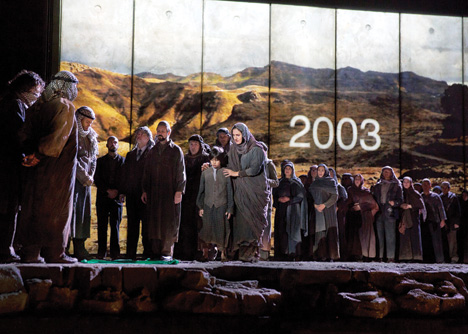
The Met’s program listed 25 productions of Klinghoffer since 1991, in Europe, the United States, and even New Zealand. These included concert performances and a heavy-handed film adaptation aired on British TV. (The Met’s was the fourth version I have seen.) Not a bad record for a relatively new opera whose creators and backers complain that it has been repressed. Certainly there have been pressures, but perhaps the creators also protest a little too much, unable to face the possibility that the opera is simply not very good, or that both its champions and its detractors may be reacting to its political implications as much as its artistic achievements (or failures). It is unlikely that Klinghoffer will simply fade from the stage because of its many intrinsic weaknesses, so more trenchant scrutiny of its underlying politics is needed. Too many critics have seemed preoccupied with those demonstrating in the streets (or in the theater) against this opera. Well, it makes snazzy copy. But it also makes for moral shortcuts and easy, if not smug, generalizations.
The opera certainly doesn’t represent Adams’ music at its best. His “post-minimalist” choruses in it are often beautiful and the orchestrations are frequently appealing. The interplay between strings and woodwinds—Adams grew up playing clarinet—can be especially attractive. Still, what passes for recitative (operatic song-speech) and aria don’t differ significantly enough or in interesting ways from each other and are frequently overwrought or droning. Goodman has suggested that the opera’s foes ruined her literary career because she broke “taboos.” That, of course, is an appealing way to think of oneself while sidestepping reasons for critical and moral censure of the libretto.
Tom Morris, the director of the Met’s Klinghoffer, considers it “powerfully relevant,” and his version seemed to want to have things all ways. At the beginning a screen announced that this was a “fictionalized” account and not “an exact reconstruction.” Well, even if the Achille Lauro had an orchestra aboard, all that would have been true, since it is an opera. Yet as the opening choruses, Palestinian and Jewish, sing one after another—they exchange costumes so that the first becomes the second—dates (1948, 1956, and so on through 2014) roll by on a screen as if to say: This is really history. A Met program note by Thomas May, editor of an anthology on Adams, says that the opera has been accused of “implicit” anti-Semitism and support of terrorism because of its “in-depth characterization of the Palestinians.” But this misses the problem entirely. An opera can be pro-Palestinian and depict Palestinian grievances without being anti-Semitic just as an opera can be pro-Zionist without being prejudiced against Palestinians. It is, however, another matter when an opera weaves old anti-Semitic stereotypes into its very texture. The Death of Klinghoffer does just that. While it speaks to Palestinian suffering, it is uncomprehending of Jewish agony and its sources.
Goodman reports that Klinghoffer originated in a joke “in rather bad taste” by Sellars as the three collaborators were finishing Nixon in China, their remarkable and highly original first opera. Sellars had turned his sights on the recent Achille Lauro hijacking and jibed that an opera should be written called Klinghoffers Tod, German for “Klinghoffer’s death.” It’s a Wagnerian in-joke, playing on Siegfrieds Tod, the title of the first version of Richard Wagner’s Götterdämmerung (Twilight of the Gods).
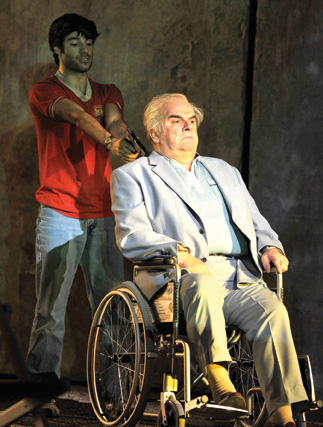
There is no better starting point to any discussion of anti-Semitism in opera than with Wagner. Both Adams and Sellars have been particularly engaged by his work, and there is nothing intrinsically suspect about that (I have been too). In Siegfrieds Tod the title character is a sacrificial victim, though as a youthful force of nature, he is radically different from the elderly Klinghoffer. Siegfried is slain by Hagen, son of the evil dwarf Alberich, who stole the Rhine’s gold and renounced love in order to have wealth and power. Siegfrieds Tod has a happy ending. Sort of. Siegfried and the celebrated Brünnhilde are immolated and ascend to Valhalla. Hagen, by contrast, is drowned in the Rhine by the “Water Women” (later called the Rhine Daughters). And Alberich “sinks” with a “lamenting gesture.” It is often said that Alberich (and other characters) invokes anti-Semitism with his lustful pursuit of the maidens and his desire for riches and power over love; Wagner, so it is claimed, is telling us that Alberich and his progeny must go under.
Wagner’s venomous essay “Judaism in Music,” published in 1850, accused Jews of many familiar sins. They controlled the artistic world, he claimed, turning culture into commerce, and dominated the press too. And Jews inevitably mangled the connections between words and music. This is especially thanks to the use of melismas—florid settings of multiple notes to a syllable—and the rhythms of synagogue music, that “nonsensical gurgling, yodeling and cackling.” Money, manipulation, and melismas lurk in the marrow, thwarting attempts by Jewish composers or poets to create anything “truly” human. Lifting this “curse,” Wagner wrote, required the “redemption of Ahasuerus—decline and fall.” That last phrase resonates in German because Wagner used a single word, a favorite, Untergang, literally “going under.”
Critics who contend that Wagner’s Jewish fixation is often embedded in his “music dramas” point often to 19th-century allusions that might not be as evident now. The allusions are certainly there, but conclusions need be cautious. There were many 19th-century treatments of the mythological Ahasuerus, the oddly named, accursed wandering Jew, and Wagner admitted he had him in mind when he composed The Flying Dutchman. The Flying Dutchman doesn’t really have anything to do with Jews, but Wagner’s sole mature comedy, The Mastersingers of Nuremberg, is another story, if a little indirectly. Some years ago a storm broke out when Barry Millington, a British Wagner expert, argued that not only was its libretto anti-Semitic, so was some of its music. In it, Beckmesser, town clerk and unbending keeper of singing rules for the Mastersingers’ guild, is an old creep who salivates for the beautiful Eva. She, however, loves the new knight in town, and her hand is the prize in an annual song contest. Beckmesser woos her by singing beneath her window and makes an ass of himself. Many critics, including Theodor Adorno, marked him out as an anti-Semitic figure; he is lascivious, limps (a characteristic often ascribed to Jews by detractors), and is the defender of law (read: Old Testament) against love (read: New Testament). Millington’s wrinkle was to show that Beckmesser’s song rouses mirth by exaggerated melismas, exactly what Wagner chastised as “Judaism” in music.
Critical howls ensued: Wagner was too much the artist to do such things, and, anyway, a Jew would never have been Nuremburg’s clerk. No he wouldn’t have been, responded Millington, but the issue is what Wagner evoked. He pointed to a letter in which Wagner wrote of another work that “I have learned to feel that to make one’s intentions too obvious risks impairing a proper understanding . . . in drama—as in any work of art—it is a question of making an impression not by parading one’s opinions but by setting forth what is instinctive.”
Goodman has not been so subtle, neither in Klinghoffer nor in her earlier, much better, libretto for Nixon in China. In it, Henry Kissinger has what might be called the Beckmesser function. He is the opera’s boor, allowing everyone else, including Nixon, to appear heroic. Goodman declared that she wanted an opera of “character” whose protagonists were eloquent. And so it is for Dick and Pat, Mao and Madame Mao, and Zhou Enlai. Kissinger, however, is a lump on legs, tongue hanging out (in Sellars’ Houston production), lusting for girls. He is “the only character I ended up disliking, and it is fitting that he is a buffo bass,” says Goodman.
In a brilliant scene Pat and Dick go to see the famous agitprop opera-ballet The Red Detachment of Women. On stage Wu, a peasant heroine, is victimized (and pawed) by Lao Szu, a creepy whip-bearing henchman of a tyrannical landlord. “Doesn’t he look like you know who?” asks Pat. Lao Szu is, in fact, sung by and played to look like Kissinger. If Beckmesser makes himself a chump by exaggerated melismas, Lao Szu/Kissinger does so with musical angularity: His voice bounds an octave as he sings that Wu is “hot.” Money is involved too. After Lao Szu brags of his usefulness, Nixon tosses him coins. (“Here friend, something for you.”) At the end of the opera, when all the other characters are busy reflecting on their experiences and history, Kissinger—the German-Jewish intellectual who fled from the Nazis—goes to the toilet.
A two-fold caution: No opera can be reduced entirely to its creators’ intentions, even if these come together to constitute a political world view open to legitimate criticism. But one must also resist the pretense that art takes place in some aesthetic ether, especially when the subject is political. When an artist, he was purely an artist, living in truth, say Wagner’s defenders. When disliking Jews, he was in a separate sphere of life. It seems absurd even to suggest such a defense in the case of Klinghoffer, which was so obviously a political intervention. But that is just it. When aspects of this opera based on events fresh to memory are challenged, defenders have a recourse that is a little too easy: How dare you? It is artistic meditation and the stage is illusion. Or they claim that it is “even-handed” or harbors some “truth” or is a “masterpiece,” whatever the historical details.
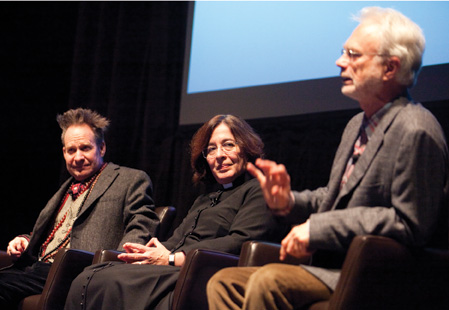
There is, of course, no opera without license. Nobody in Venetian audiences in, say, 1642 would have thought seriously that debate between Nero and Seneca in Monteverdi’s Coronation of Poppea aimed to clarify political morality in ancient Rome. Remote history was deployed to address contemporary Venice; the historical Nero and Seneca did not sing to each other about the merits of rule by emotion as opposed to those of reason. We can be sure that Leon Klinghoffer’s assassin didn’t sing to him either.
Some advocates try to deflect censure of Klinghoffer by suggesting that all negative criticism of it comes from political “hardliners” (for the record, I am a left-of-center dove) or gesture irrelevantly at supposedly larger contexts. Take, for instance, musicologist Michael Steinberg’s liner notes for the opera’s first recording, in which he sneered that the opera was completed as the United States dropped “smart bombs” on Baghdad and premiered at the Gulf War’s end. These facts, it seems, should make us wonder who the real terrorists are. But what did the murder of an old man on a cruise ship in the Mediterranean in 1985 have to do with a war half a decade later, far on the other side of the region, provoked by Iraq’s invasion of Kuwait?
Actually, it is possible to make a kind of connection. The PLF’s leader, Abu al-Abbas, who masterminded the Achille Lauro hijacking and spent 10 months planning it, was a paid proxy of Saddam Hussein within Palestinian politics. He and Yasser Arafat applauded Iraq’s occupation of Kuwait. Arafat’s role in the Achille Lauro affair is uncertain (the PLF was a faction within the PLO). When the Met production projected “historical” pointers onto a screen, it told viewers that he denounced the hijacking, but neglected to mention that he pioneered the very tactic, along with making attacks on civilians and evasive pronouncements afterwards to elude responsibility. Targeting innocents was also regular PLF practice. The Achille Lauro’s hijackers demanded freedom for some 50 men in Israeli prisons, including “the great man from Nahariya”—the PLF’s Samir al-Qantari, who had murdered a child (and others) in the name of liberation in northern Israel in 1979.
Taking political sides doesn’t necessarily make an opera or an argument anti-Semitic. Yet something is amiss, something should make us queasy, when proponents speak of “truths” without explication or don’t perceive that sides are being taken. When the opera was still a work in progress Sellars insisted that “the boys,” that is the hijackers, not be called “terrorists.” Well, boys will be boys and great men, like al-Qantari, will be great men. Adams says that “we weren’t making an overly conscious attempt to be neutral,” and after studying the background “it was impossible not to have strong feelings.” Still, he wonders why Klinghoffer was killed. “Whether this was a kind of Nietzschean decision on the terrorist’s part I don’t know . . . It seems like a kind of hectic, rash decision.” Does it seem so? And the previous seven PLF operations, each of which entailed hostage-taking—were they preceded by responsive reading of Nietzsche’s Beyond Good and Evil? Adams thinks that “neither side” in the Achille Lauro affair “is beyond reproach. Nor can either side be condemned.” Neither side? For what, exactly, would Adams reproach Leon Klinghoffer?
Klinghoffer’s trio of creators has spoken openly of the kind of research they did while preparing it. Adams tells us he read about “the history of the Israeli-Arab conflict, the roots of Zionism, the Balfour Declaration, and the long history of British, French and American meddling” in the region. (Oddly, he seems to have missed German and Italian meddling in the 1936 Palestinian Arab revolt and the vigorous activities on behalf of the Third Reich by Palestinian nationalist leader Hajj Ammin al-Husseini.) He reread the Old Testament and the Koran (“difficult going”). He found Noam Chomsky’s writings “one-sided” but those of Edward Said “more reasonable.” And Adams learned that “the Israeli-Palestinian issue was the most carefully controlled and fastidiously managed debate in American political life” due to “lobbies” which spoke moderately in public but whose “considerable clout in Washington often smothered” efforts to present the Palestinian side in public.
Sellars believed the opera to be “beyond all political differences” because it was “human,” as if political differences are not human. It is, he thinks, comparable to Bach’s Passions and Greek tragedies. Goodman read “the Koran, the Book of Lamentations, the Psalms, Brecht” and Spanish Renaissance poetry. Absent from any of their studies were explorations of the history of anti-Jewish prejudices (Christian, Muslim, secular) and how they have been presented in theology, in politics, or, say, on stage. To what extent do old tropes continually reappear, consciously or not, in new costume—tropes about obstinate, self-occupied Jews; rich, materialistic Jews; wily and screechy ones with hidden powers?
Before denying that anti-Semitic themes are embedded in Klinghoffer you must reflect on them in the first place. Adams does not seem to have done so and neither, apparently, has Anthony Tommasini, music critic of The New York Times, who long ago embraced Adams’ claim that Klinghoffer offers “the sad solace of truth.” His article entitled “Toward a Truth That Defies Precision,” published after last fall’s controversies, hails the opera as “courageous” and dismissed “parsing ‘Klinghoffer’ for evidence of a pro-Palestinian slant” because “artistic issues” would thereby be “sidelined.” Can an artist “tweak or fictionalize a story for artistic ends?” he asks. Does not art, especially music, have particularly important powers “to explore the emotional interiors of fictional and nonfictional characters, especially bad ones . . . ”? He compares Lady Macbeth to the terrorists in Klinghoffer. “Just by giving voice to those being portrayed, music, in its subliminal way, can seem to be revealing inner lives and feelings” together with “seething grievances.” An artist, after all, may provide “a fresh way” of perceiving a “historical event” and thereby “lead to a deeper understanding of what was going on.” Journalists may be averse to fidgeting with facts but “on balance, artists can claim the right to bend a story to their aims.”
But of course artists tweak stories—that’s what they do. And of course art and especially music have unusual capacities to explore inner lives and grievances. The difficult question is: What are the implications when talented artists tweak history for political reasons, harnessing creativity for untruthfulness or perhaps, to be gentler, smug ignorance? After all, didn’t Leni Riefenstahl’s camera give fresh perspective on a political event?
Klinghoffer and Triumph of the Will are not of a piece. Still, doesn’t comparing them make more sense than speaking in one breath of Macbeth and Klinghoffer? What do we know of one Lady Macbeth? Is Shakespeare’s tweaking of Holinshed’s Chronicles the same as Sellars’ tweaking of the history of PLF? Do historical proximity and political purpose count for anything at all in our judgments of artistic representation? If they don’t, then everything is simple: The better the imagination the better the propaganda. Or you can call it a matter of myth or spiritual depth, providing other layers of protection from scrutiny.
In a fall 2001 interview Adams avowed that Klinghoffer’s “sacrificial” murder was akin to the crucifixion in Bach’s Passions. “Both Jesus and Leon Klinghoffer were killed because they represented something that was suspect and hated.” But Jesus goes knowingly to his fate as part of God’s plan for humanity’s redemption while Klinghoffer was an elderly cripple on a last vacation with his terminally ill wife. For whose sake is he sacrificed? Jews? Palestinians? The souls of the opera’s audience? According to Bach’s Saint Matthew Passion, Jewish hatred led to Jesus’ death and culpability followed. Has Adams ever thought this through? Before, or after, all the controversy?
Accused of creating “CNN operas,” Sellars insists his aim is the opposite. Among “the most important reasons” for his kind of opera, he explains, is to alter American understanding of the world since media frenzies distort “actual history.” In our “Age of Information,” he elaborates, “we are strangely underinformed” and an opera can provide “a structure which is context rich,” filling in the “historical blank.”
Few can doubt that our news media are fast-moving and shallow. Is Sellars the credible alternative, the exponent of “actual history”? Oedipus Rex, he says, is not about “an exploding eyeball” but “why someone would dig out their own eyes.” Whether it is Oedipus or suicide bombers or 9/11 hijackers, he explains that “the question that is not allowed to be asked to this day is ‘Why would people do this?’ That’s the question, of course, that drama asks. Exactly to find what was not in the news, what was missing from the news: that’s why we worked in this genre.” The headline is not essential but rather providing “a longtime picture” is the essential goal.
A long time indeed. It seems to me that Sellars’ “question” has been asked for about as long as anyone has thought about history or theater. Answers, of course, may differ. Adams, Sellars, and their critical defenders have a bizarre sense of history. As we have seen, to fill in the “historical blank” they pair Lady Macbeth and the Palestine Liberation Front, Jesus and Klinghoffer, Oedipus and Osama. What Sellars calls the “longtime picture” depends, of course, on how, and if, you understand events. In the 20th century, according to Sellars, the United States was “the oppressor against every popular democracy movement” (presumably Washington did not oppose Nazi or Stalinist oppression). But Americans have never been “allowed” to ask, “What are these people hoping to achieve?” he says. Let’s bracket all of the journals, editorial pages, and books Sellars has apparently never read and examine how he sees the relation between art and democracy:
Democracy is the creation of and ability to sustain an environment where even difficult things can be talked about without inflicting further damage, in an atmosphere where all sides can be heard, as Alice Goodman likes to say, “as eloquently as possible,” and where the structure itself is large enough to contain all the voices. The heart of the operatic form is simultaneity, where all things are held in contingency. You have to recognize everything as part of a larger interlocking structure. That has incredible social and political implications.
This eloquent scramble seems to confuse democracy (which only works when people listen to each other) with a postmodern version of Wagner’s Gesamtkunstwerk (a total work of art in which word, music, and dance meld). But in the end, “context” for Sellars—it is one of his favorite words—simply means tweaking stage events on behalf of his own views.
In fact, Sellars wanted Klinghoffer to be “much more pro-Palestinian than it is,” according to Goodman. Klinghoffer “deals with Palestinians,” says Sellars, but it “is about Americans in the middle of the situation, through the Klinghoffer family.” Here we must turn to a few lines in the libretto. Early on Molqi, the PLF team leader, sings
. . . we are
Soldiers fighting a war.
We are not criminals . . .
But men of ideals
Later, “Rambo,” a nickname for the most mean-spirited of the Palestinians, responds with contempt to Leon Klinghoffer’s one speech against his tormenters with this:
You are always complaining
Of your suffering
But wherever poor men
Are gathered they can
Find Jews getting fat
. . . America is one big Jew.
In his liner notes, Michael Steinberg admits this taunt is “nasty” but finds it “eloquent and horribly truthful,” indeed “a speech of a lifetime” because—and here he follows Adams—it tells off its bourgeois audience. What horrible truth? It would seem to consist in the identification of Jews with America and then both with global exploitation. More circumspect defenders of the opera argue that the pronouncements of Molqi and Rambo express what some Palestinians think, not the creators of Klinghoffer. Yet doesn’t Rambo’s war against the “one big Jew” justify Molqi’s self-image as a man “of ideals.” And, with fervor tempered, how distant is this really from Sellars’ world view?
It is true, as Times critic Tommasini stresses, that the arts reveal human sensibilities in special ways. But one way is prejudice, as in the case of Wagner’s Beckmesser. As Klinghoffer opens a “Chorus of Exiled Palestinians” sings a grieving, beautiful plaint: “My father’s house was razed/In 1948/When the Israelis passed/Over our street.” Thus the opera begins by identifying the Israelis with the Angel of Death in the Passover story. A female voice sings of her house with a “pure well” from which all could drink. But “Israel/Laid all to waste,” and men’s voices join in intensifying anger at “the supplanter.” The doleful “Chorus of Exiled Jews” introduces a more artificial world: “When I paid off the taxi, I had no money left.” If Palestinians invoke loss of their idyllic natural place, wandering Jews mourn lost cash. The Jewish chorus becomes a love song to “the daughter of Zion” and, as music critic Edward Rothstein neatly summarized it, Israel represents in it “a sort of tourist’s recollection of devotional sentiment about the Promised Land, mentioning sights like military barracks, the Western Wall, movie houses picketed by Hasidim . . . and a goat in an orchard.” Jewish history is context-less, save for the memory of the Holocaust. There was no Jewish problem before then. If these choruses display even-handedness, it is with one hand cuffed behind the back.
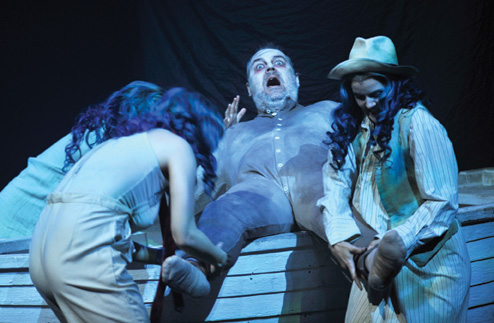
Does this construction rest on Goodman’s scorn for her own education as a comfortable Reform Jew in Minnesota? “We were shown movies of the Holocaust in Sunday school,” she recalls, “. . . to create a sense of us and them. And it seemed to me that this was the wrong idea altogether.” She “converted to Christianity between writing the choruses and arias of Klinghoffer.” Ordained in the Anglican Church, she began to minister in London to a mostly Palestinian congregation. Goodman has also noted with evident amusement that her conversion posed a possible public relations embarrassment because “John and Peter and I had always said cheerfully that if anyone objected to the libretto they could push me forward because I’m Jewish.”
Those who went to the opera’s 1991 premiere in Brussels would have seen an oddly named Jewish family from New Jersey. “The Rumors” appeared between the two opening choruses, and Adams says they mirror the Klinghoffers. They live comfortably in a suburban world of materialistic well-being: ivory carpet, a fake Jackson Pollack, magazines like Architectural Digest and The New Yorker on a coffee table. Harry watches Reagan on TV (“What a mensch!”) while his wife Alma calls the president an “asshole.” As their visiting 30-year-old son Jonathan eats cold spaghetti, Mr. and Mrs. Rumor chatter about experiences on a luxury cruise. Well, rumors travel; they commended it to Leon and Marilyn. And money is always on the family mind. The dollar is up, says Harry; “good news for the Klinghoffers,” says his son. They will have a great time, remarks Jonathan sarcastically: “Friday, Manhattans by the pool/Saturday Eretz Yisroel.”
The affluent, world-wise Rumors have many souvenirs in their home. Harry describes Alma’s encounters with natives selling their wares:
. . . Tourist traps
And sweatshops on five continents
Turn the stuff out. Your mother haunts
The markets when we go ashore,
Looking . . .
. . . for some
Hideous relic to bring home.
Out rush the natives at first sight
Of her enormous summer hat
Rubbing their hands . . .
You were in the toilet all the time, she ripostes. (Perhaps he was waiting in line behind Kissinger.)
Yes, the Rumors are materialistic, although in different ways. After more banter—Jonathan should meet a nice girl!—the scene ends with Mrs. Rumor expressing disdain for Yasser Arafat and bother at press reports about world misery. “It’s never-ending. God knows why/I still get angry, but I do,” she says with the oblivious compassion of a well-heeled liberal consumer.
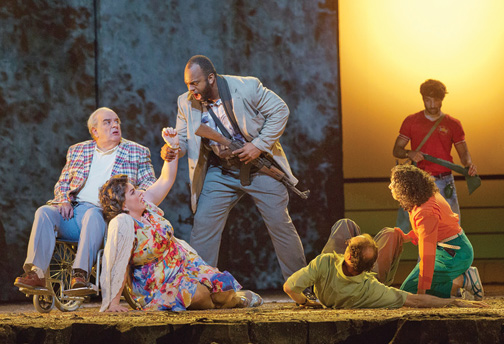
Like Beckmesser, the Rumors represent a type, in this case someone you would find on the Achille Lauro. Instead of Beckmesser’s melismas, there is sitcom-like music; mockery after the Palestinian lament. Adams insisted that the scene was not anti-Semitic but misconstrued so badly by some viewers that it was removed to allow “the rest of the opera” to be taken “seriously.” Still, he “very much enjoyed Alice’s sly humor” in what was supposed to be a “comedic interjection in the middle of an intensely tragic narrative.” He doesn’t ask if the motifs of the Rumor scene still thread the opera even with it gone. For Goodman, who like Adams assimilates the Rumors and Klinghoffers, more was at stake:
I think what upset a lot of people was that the libretto violates certain taboos . . . People didn’t like the way that I presented Klinghoffer as an ordinary, touchy, vulgar bourgeois—there’s this Jewish fantasy that our heroes and our victims are always either highly cultured or pious. Well, some of them can be very vulgar—we aren’t all Nathan the Wise. And we have behaved very badly towards the Palestinians, they have justifiable grievances, and we and they are very, very much alike—temperamentally, culturally, in family dynamics and in ultimate origin.
Given Goodman’s depictions of Jews and the way that she imagines the dramatic alternatives—either Jews are impossibly perfect like Lessing’s Nathan the Wise or they are vulgarians like her Klinghoffer—her use of the first person plural is jarring. (She is Jewish, she has elaborated, by “nearly every definition” except that she has become a Christian.)
Now imagine some changes in the scenario. Suppose a Jewish chorus opens the opera, adding to Goodman’s clumsy Jewish mourning some lines about the pogroms of 1881 and the Mufti in Berlin. Then Palestinian sitcom music lightens the mood. Keffiyehs on their heads, men of the al-Hearsay family sit outside their stone hut, fiddle with beads, and smoke hookahs. Goats wander about as they banter in guttural sing-song; but melisma animates their voices when, agitated, they refer to infidels, arrogant Zionists, and jihad. The women are inside preparing kabob. The accompanying music, interspersed with a muezzin’s call, is a monotonous, screechy combination of strings and drums: oud, rebab, and tabla. And then Palestinian sorrow intones: “My father’s house was razed/In 1948.”
Would this honor Palestinians as Goodman says that the opera honors Jews? Or would it be rightly skewered as a Palestinian Beckmesser scene, as prejudiced images of Palestinians, indeed all Arabs? And then what if motifs with horrible truths from this “sly humor” reappeared throughout the opera? Would any self-respecting critic (or sophomore literature major) think the fact that the scene had been removed after the first showing meant it was irrelevant to an understanding of the work?
There is an anomalous but curiously telling symmetry between the endings of Wagner’s Tristan und Isolde and Klinghoffer. At the beginning of Wagner’s opera, its protagonists cross waters towards a destiny that unites them in unrealizable love, death, and the cosmos; at the end, wounded Tristan lies dying as he awaits Isolde, who travels by boat with a potion hoping to save him. Klinghoffer gives us a couple on a last vacation together aboard a ship. The sea will finally separate them. In both operas the male protagonist dies and then the female protagonist sings a closing aria.
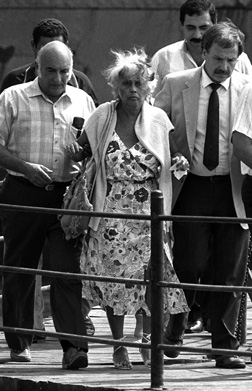
In the original staging, Leon was shot offstage but his murder takes place before our eyes—he is shot point-blank—both in the BBC film and in this fall’s Met production. As Klinghoffer goes under, Adams provides an “Aria of the Falling Body.” Klinghoffer’s time has stopped, but that of the cosmos continues endlessly as the now former Jewish vacationer sinks into it and dissolves into it and universality. (Klinghoffer’s bullet-ridden corpse was actually found off the Syrian coast after al-Abbas and Arafat announced that he had died of a heart attack.) The music, mostly soft and solemn, but with intensifying strings at points and a poetic oboe weaving in, is virtually the opposite of Siegfried’s Funeral March, music given to the dead hero of Götterdämmerung. Staging Klinghoffer in a convincing way is not so simple; in the Met production the corpse was upright; since cinema allows a harsher realism, viewers of the 2003 film saw the recognizable body with a bullet hole in his forehead sink in the waters; Sellars’ staging had a dance of body and soul as a shrouded double of Klinghoffer led him on.
In 2003, Berkeley musicologist Richard Taruskin argued that the music accompanying Klinghoffer’s descent betrayed deep biases in the opera. Pointing to Adams’ frequent comparisons of Klinghoffer to Jesus in Bach’s Saint Matthew Passion, Taruskin noted that Jesus’ words are accompanied by an “aureole” of violins and violas, effectively providing a kind of halo in sound. Adams provides a comparable luminosity as Klinghoffer’s body falls. However, something similar—call it musical sanctification—is heard elsewhere in the opera solely to accompany Palestinians. We hear it in their opening chorus, we hear it when Molqi declares his squad to be “men of ideas,” when one of his accomplices sings of love songs, and when another expresses his desire for martyrdom. We don’t hear it complimenting their victims, only the descending Leon. “Only after death,” concludes Taruskin, does the familiar middle-class American Jew join glamorously exotic Palestinians in mythic timelessness. Only as his body falls lifeless is his music exalted to a comparably romanticized spiritual dimension.” UCLA musicologist Robert Fink has replied to this argument, in a snarling and intellectually shabby article cited widely in the press last fall. Dismissing early critical reception of the opera’s BAM premiere as merely the response of “Brooklyn” Jews translating worries about American Jewry into anger at an opera, Fink lambasted Taruskin for not hearing “aureoles” elsewhere in the opera, in particular in Marilyn Klinghoffer’s final aria.
Fink missed the larger political point: The “aureoles” sanctify moral and collective claims for the Palestinians and only individual tragedy for Jews. Marilyn’s aria is one of agony, an expression, as would be expected, of excruciating private pain at her husband’s murder, but it lacks the cosmic dimension of the Liebestod, the powerful love-death aria that Isolde sings over Tristan’s body as she sinks into the “surging swell.” Marilyn just sings of loss and her own wish to die (she would, in fact, four months later). An audience is usually stunned after hearing Isolde; Marilyn’s Liebestod is musically strained anger, leaving listeners (or at least this one) anxious for its completion.
Yet what seems entirely personal at first does get reconnected in an odd way to Jews; Marilyn Klinghoffer’s voice, towards the aria’s end, is joined by those of a women’s chorus in the same key of G minor we heard in the “Chorus of Exiled Jews” at the opera’s beginning. But of course those exiled Jews were just complaining tourists. And now her vacation has been disrupted by the world’s woes, the kind of woes her friend Alma Rumor tried to but could not quite avoid.
Although Alice Goodman maintains that “Anyone who attends this opera with an unprejudiced mind will perceive that it does honor to the destiny of the Jewish people,” it would be more accurate to say that it honors them only as they go under. Such aestheticization of political murder must be called out for what it is, particularly now. (As it happens, I wrote much of this essay in Paris during and after the Charlie Hebdo and Hypercacher market massacres in January 2015.) The Death of Klinghoffer is, in fact, completely uncomprehending of collective Jewish history and tragedy. It may aspire to be an artwork of complex moral and historical imagination, but it depends on rumor.
Comments
You must log in to comment Log In
Suggested Reading
Looking Backward and Forward
Response #2: David Biale revisits his provocative 1998 essay on Jewish assimilation.
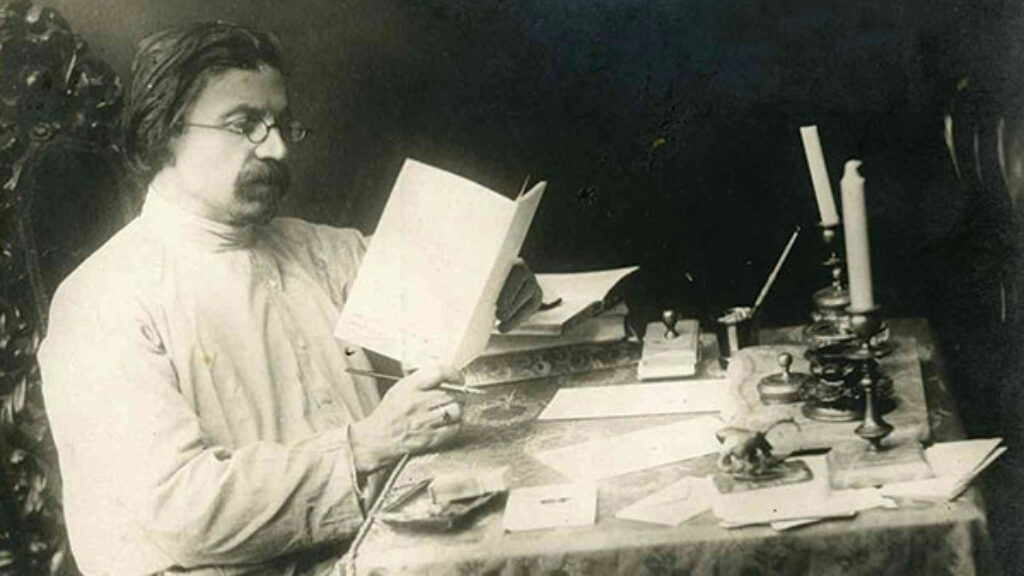
Moshkeleh the Thief
“The holiday is also sweet and dear because poor and dejected Jews toil hard, alas, and struggle, and just barely, in the nick of time, amid great trouble, angst and tribulations, bring in the holy holiday. Now, finally, they can rest and relax for eight days in a row.” A new translation of Sholem Aleichem by Curt Leviant.
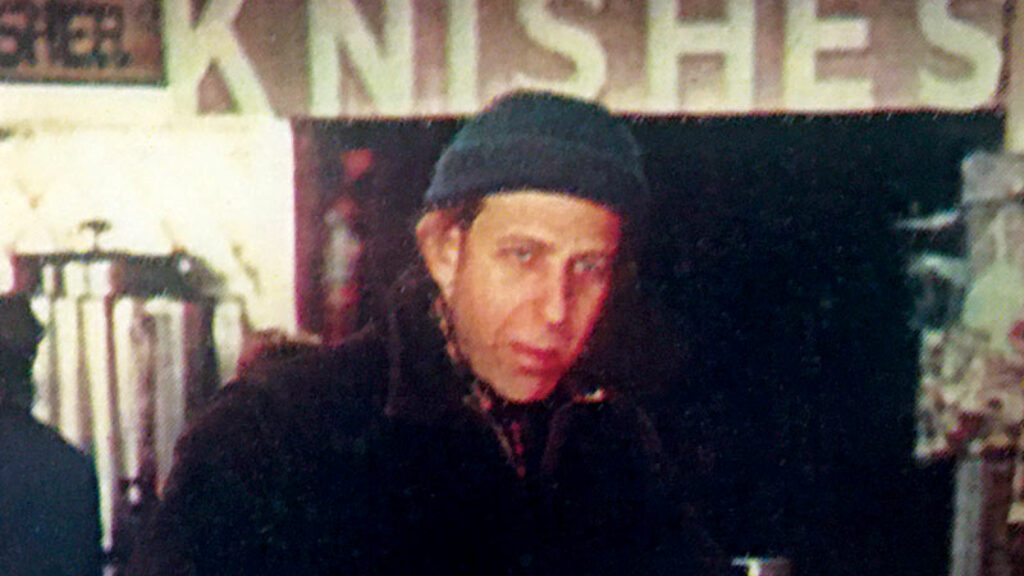
Working One’s Way Out
"When I first read Winter Vigil over a year ago, I was swept away; I hadn’t read any contemporary writing as good in a long time. I hadn’t known Steve Kogan could write like that. I hadn’t, it turned out, known very much about him."
The Wages of Criticism
The great 18th-century talmudist Rabbi Aryeh Leib Ginsburg never whitewashed his disagreements with other scholars, claiming that most "ruined good paper and ink and embarrassed the Torah." According to a popular rabbinic legend, his downfall came when, in an act of cutting vengeance, the books he had criticized came toppling upon him.
name withheld
This article is brilliant and erudite, persuasively and beautifully written. May it be read widely and taken to heart. My gratitude for it is offered not only to its author but to The Jewish Review of Books for publishing it.
gwhepner
THE DEATH OF KLINGHOFFER LEADS TO DEATHS OF SOTLOFF AND FOLEY
Let the supplanter look
upon his work. Our faith
will take the stones he broke
and break his teeth.
The lyrics Alice Goodman, music Adams,
the Passion of St. John declared this too:
the Jews are always blamed, the world needs totems
for innocence presumed to them taboo.
It’s always kosher to
throw stones at Jews and safe
to label acts they do
in self-defense as trayf.
Such moral equivalence
with stare decisis
to Jews’ death ambivalence
the crisis, not ISIS.
[email protected]
apologues
This article is on the money, but the author has brought out a piece of heavy artillery to bring down four gnats. The key point is the inveterate shallowness of all the principals here: Sellars, Adams, Goodman, and the general manager of the Met, Peter Gelb. After the unexpected success of "Nixon in China," Adams and Goodman went looking for something else topical and sensational. I see Adams as opportunistic and superficial, as proven by his by-the-numbers memorial piece for the victims of 9/11. I'm going to assume that he is not anti-Semitic, and that he had no notion in "The Death of Klinghoffer" of valorizing terrorism. No one is crazy enough to court a New York success with an overtly anti-Jewish work. He just wanted to be evenhanded. It's true that as a card-carrying liberal, Adams sympathizes with the Palestinian cause; but after all, the opera culminates in shooting a helpless man in the head. It's hard to make that heroic.
It seems clear to me that the problem isn't that Adams and Goodman sided with the Palestinians: it's really more the case that they didn't take sides at all. You could write the opera with conviction only if you did; and to write it without any convictions was to risk being the only people in the opera house who lacked them. If you aren't going to vindicate the Palestinian hijackers – hard to do but that WOULD be edgy – then you've got nothing, because saying "Boo! Hiss!" to terrorism – "We have the courage to condemn the cold-blooded murder of a victim chosen at random!" – is a little too easy for a New York audience. So all they had going was their calculated effort to play it safe while trying to appear as if they didn't.
As all the quotes in the article confirm, Sellars, Adams, and Goodman did no coherent thinking about their treatment of this subject and appear to be incapable of it. They thought deeply only about the box office potential, and miscalculated badly about what would ring the cash register. When you are operating out of pure opportunism, this happens: you forget to factor in how actual people feel about what they are seeing; instead you are thinking, "Innovative, daring, an act of horrific violence – what can go wrong?" So they just filled in the schema: open with a Palestinian chorus, then cue the Jewish chorus. It doesn't help when your librettist specializes in postmodernist opacities fit only for advanced aesthetes with a chai in one hand and the latest New Yorker fiction in the other.
Anthony Tommasini's coverage for the Times, taking these hucksters seriously and philosophizing about what music can achieve in the op-ed realm, was a perfect match for the meretriciousness of the production. There isn't time to detail all his evidence of his fatuousness, but I will mention just this: "In the libretto, the murder takes place offstage. Here, it is depicted explicitly, which should silence detractors who charge that 'Klinghoffer' explains away a vicious murder." Well, that did answer an objection that wasn't worth responding to, at the risk of creating another that was much more valid: that the pornography of violence now rules the day at the Met. Putting the murder on stage, in defiance of the libretto, was just another chapter in the increasing vulgarity of Peter Gelb's new productions. During the same season, Verdi's "Macbeth" was unutterably cheapened by its graphic presentation of Banquo's murder. But no question, Gelb was the right guy to bring "Klinghoffer" to the Met stage in all its smarminess and banality.